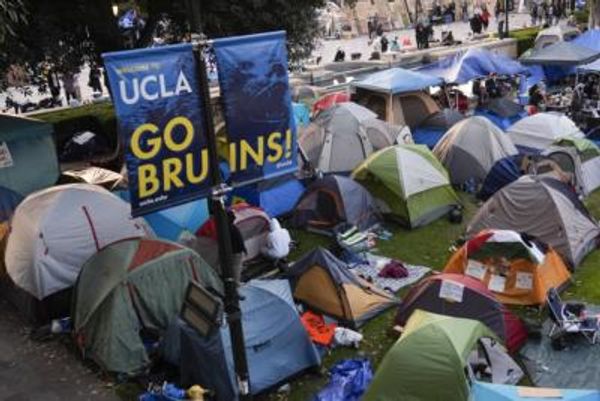NEW YORK — Thousands of nurses walked off the job early Monday at two major New York City hospitals after contract talks disintegrated overnight, leaving Mount Sinai in Manhattan and Montefiore Medical Center in the Bronx struggling to care for patients.
In parallel chaotic scenes across two boroughs, striking nurses began picketing in the early morning hours as both hospitals were left without a total of more than 7,000 unionized nurses seeking better working conditions and higher pay.
“I’m here because we’re tired. We are tired,” said Louise Louanga, who walked a picket line at Mount Sinai where she’s worked as a nurse since 1991. “Every day we are short.”
The strike comes after years of nurses sounding the alarm about staffing shortages and poor working conditions at several city hospitals, and two weeks after union nurses delivered 10-day strike notices to eight hospitals throughout the five boroughs.
After agreeing to tentative contracts with six other city hospitals, the New York State Nurses Association was still at loggerheads with Mount Sinai and Montefiore as of Monday morning.
“After bargaining late into the night at Montefiore and Mount Sinai Hospital yesterday, no tentative agreements were reached,” NYSNA said in a written statement put out early Monday. “Today, more than 7,000 nurses at two hospitals are on strike for fair contracts that improve patient care.”
A day earlier, Gov. Hochul attempted to avert the strike and called for binding arbitration to “swiftly reach a resolution.”
“The New York State Department of Health will continue to enforce staffing requirements under the law at these hospitals to maintain the delivery of essential health care services to the community and protect patient health and safety,” she said in a statement released Sunday evening. “The Health Department will continue to ensure that all providers are meeting the requirements of the law.”
Despite her overture, NYSNA moved forward with its walk-out plans.
Outside Mount Sinai on Monday, the picketers included a band replete with a tuba, trumpet, tambourine, drums and a guitar. They were greeted with horns honking in support from passing cars and onlookers who overwhelmingly said they back the nurses.
Eli Calona, 38, of the Bronx was there with her 1 1/2-year-old son, Ian, for a cardiology appointment.
“They told me there’s going to be a strike, but it was pretty easy inside, pretty normal,” Calona said. “The nurses were great before. I was in here for four months after he was born, and they were really awesome. I support them.”
Chastity Velez, 30, of East Harlem, wasn’t aware of the strike until she brought her 4-year-old son to Mount Sinai’s pediatrics unit Monday morning to be treated for RSV.
“I wasn’t expecting people to be in my way. I just wanted to go to the doctor,” said Velez, who works as a home health aide. “I definitely feel for them. Hopefully, this doesn’t take too long.”
In spite of the support, a spokesperson for Mount Sinai laid blame for the strike at the feet of the nurses, saying they abandoned contract negotiations at 1 a.m. on Monday.
“NYSNA continues its reckless behavior, rejecting Governor Hochul’s proposal for binding arbitration. The governor’s proposal would have provided a path to avoid this strike, which sadly is forcing nurses at the Mount Sinai Hospital to leave their patients’ bedsides,” the Mount Sinai spokesperson said. “They refused to accept the exact same 19.1 percent increased wage offer agreed to by eight other hospitals, including two other Mount Sinai Health System campuses.”
Nurses union spokeswoman Kristi Barnes said the primary issue leading up to Monday’s strike was not wages, but a failure to reach an agreement on staffing and measures that would enforce nurse-to-patient staffing ratios.
“When they say the ‘same’ thing, they’re just talking about the wages,” Barnes said. “They’re not talking about safe staffing.”
Carol McGowan, who’s worked as a nurse at Mount Sinai for 30 years, described staffing as the biggest concern among nurses by far.
Monday, she said, marked the first day she’s walked off the job in her 45-year career as a nurse.
“The safe staffing issue has been going on since the COVID pandemic, but we did what we could do during COVID. And now, COVID is over. The pandemic is over, and we are still short 500 nurses,” she said. “I feel sad. I feel happy that everybody’s here, but I’m sad that the patients aren’t getting the care they deserve — but I am not to blame for that. Management is to blame for that. Management pushed us here, and it’s on their head.”
A spokesperson for Montefiore said it would “remain committed to seamless and compassionate care, recognizing that the union leadership’s decision will spark fear and uncertainty across our community.”
Nurses at a dozen city hospitals had been negotiating new deals after their contracts expired on Dec. 31 over wages, staffing levels and health care benefits. Staffing levels became dangerously low after many nurses fled their jobs over burnout many suffered during the COVID-19 pandemic.
Tentative deals were reached in recent days with the Bronx Care Health System, Flushing Hospital Medical Center, The Brooklyn Hospital Center and Richmond University Medical Center, while nurses at Maimonides Medical Center settled on Friday and New York Presbyterian nurses ratified their deal on Saturday.
On Sunday, Mount Sinai Morningside and Mount Sinai West also reached deals that included wage increases of more than 19% over three years.
Mayor Adams urged nurses at the two holdout hospitals to continue their negotiations, but said the city was ready to “meet the challenges.”
Mount Sinai officials said over the weekend that the threat of a walkout had forced the hospital system to divert ambulances to other facilities, postpone elective and heart surgeries, find alternative treatment locations for cancer patients and transfer sick babies from its newborn intensive care unit.
More than 120 nurses work in Mount Sinai’s NICU, which has 46 beds and treats more than 1,000 newborns each year, often from other hospitals in the region.
Montefiore’s emergency department is the most heavily used in the state and among the five busiest in the country, according to the Bronx hospital’s website. It gets about 275,000 adult patient visits a year from the city, Westchester County and Connecticut.
The FDNY said in a statement that it was making plans to reroute ambulances away from affected hospitals, and the city’s Office of Emergency Management set up a “situation room” to keep tabs on the ramifications of a possible strike, officials said.
As Montefiore, Mount Sinai and the city scrambled to fill the void left by the unionized nurses, powerful union leaders signaled that they remain in solidarity with NYSNA.
“Union members across the city and state, from the public sector, private sector, and building trades are united in our support of the nurses represented by NYSNA, who have been put in the unfortunate position of having no other choice than to strike,” said Mario Cilento, president of the New York State AFL-CIO.
“These nurses are dedicated professionals who provide quality patient care under unimaginable conditions including short staffing, which were only exacerbated by the pandemic. The hospitals treatment of these nurses is proof that all their words of adulation for their healthcare heroes during the pandemic were hollow.”
The nurses union urged patients and New Yorkers seeking medical care to do so immediately and disregard picket lines at hospitals.
“If you are sick, please do not delay getting medical care, regardless of whether we are on strike,” NYSNA said in a statement. “Patients should seek hospital care immediately if they need it. We would rather be the ones providing that care, but our bosses have pushed us to be out here instead. We appreciate solidarity from our patients — but going into the hospital to get the care you need is NOT crossing our strike line. In fact, we invite you to come join us on the strike line after you’ve gotten the care you need. We are out here so we can provide better patient care to you!”







